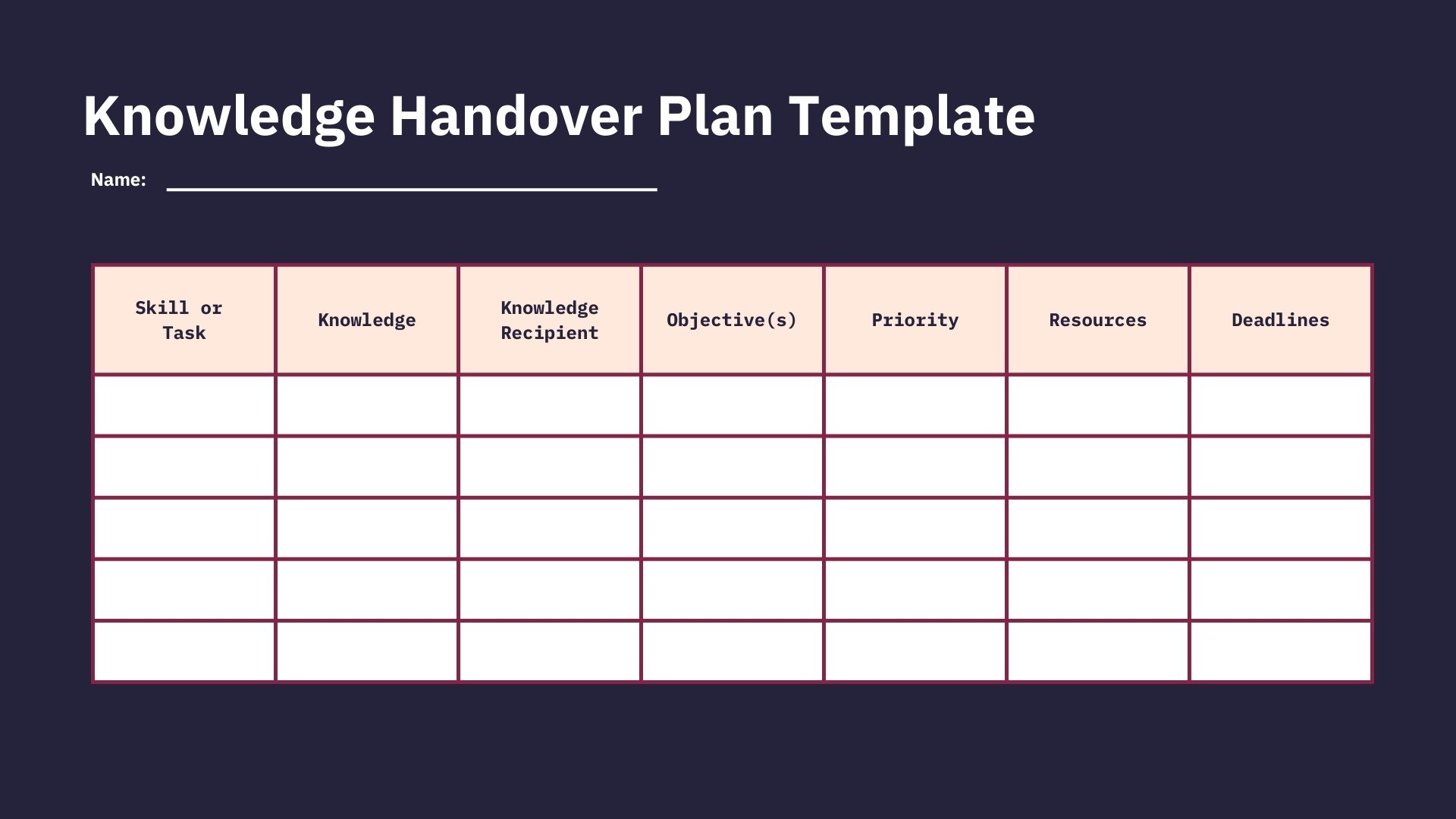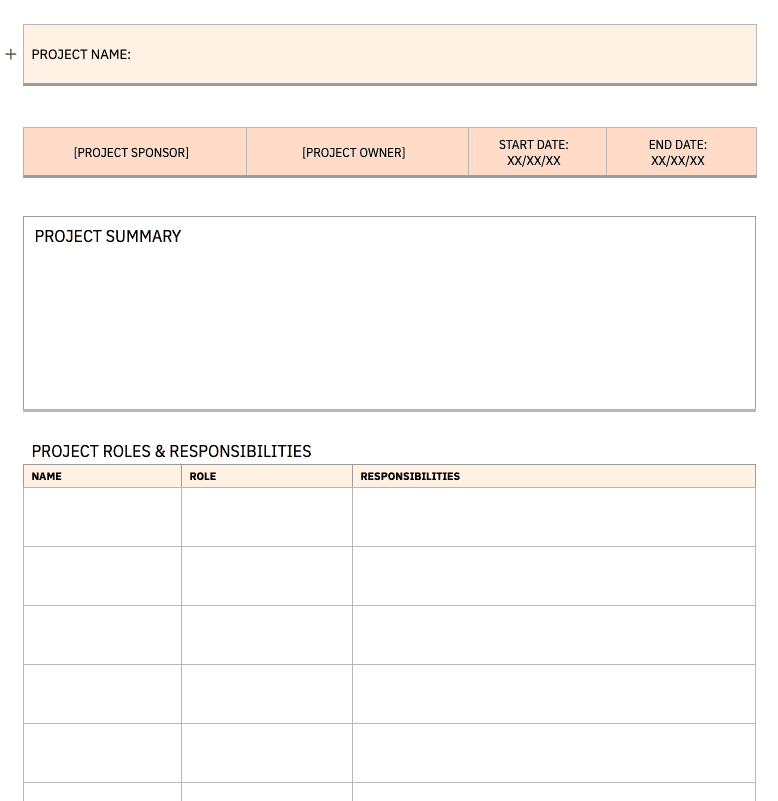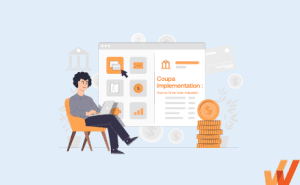How to Create Helpful Handover Documentation (+Template)
- February 23, 2023


Organizations in all industries dealing with change management, employee turnover, and employee onboarding must rely on handover documentation to transfer information and responsibilities efficiently, with as little workflow interruption as possible.
Regardless if we’re discussing a new employee, a change in job roles, or a project handover, having clear and comprehensive process documentation is crucial for a smooth transition.
Here, we’ll explore the importance of handover documentation, learn how to design and structure it, and show you four effective and helpful documentation templates you can use in your organization.
What Is Handover Documentation?
Handover documentation refers to the essential or critical information that transfers a task, project, or job role from one person or team to another.
This documentation typically includes information related to a project’s scope, duties, timeline, deadlines, budget, deliverables, challenges, and any other vital data. The purpose of handover documentation is to ensure a smooth transition and continuity of work, regardless of the underlying reason for the change.
Effective handover documentation should be clear, concise, and relevant to the context of the handover. It should allow the person or team taking over to quickly understand the project’s current state and easily take over the day-to-day tasks and associated responsibilities.
Types of Handover Documentation
Depending on the industry, the nature of the handover, and the needs of the parties involved, we can talk about several different types of handover documentation:
1. Knowledge handover
Knowledge handover documentation or knowledge transfer plans are a common practice in many industries, whenever it’s necessary to train a new employee or a new team on a task or a project. The purpose of knowledge handovers is to quantify, qualify, structure, and capture your learnings in a way that’s understandable and easy to follow for the person taking over.

2. Project handover
Project handover documentation comes in handy throughout the entire project development journey each time one team completes their job and hands off the project to the next team. For instance, project handovers can be given from the design team to the development team to take over and finalize the project.

3. Offboarding handover
When an employee leaves the organization or moves to a different job role, HR is responsible for deploying a structured employee offboarding process. Offboarding handover documentation is a part of this process since it serves to tie up all the loose ends and transfer all the know-how and on-the-job experience from the departing employee to the new employee.
4. Department handover
Department handovers occur when there’s a restructuring of the roles and responsibilities within an organization or when a department is closing down. The goal of the department handover documentation is to ensure that the new department has all the necessary information, tools, skills, and resources to continue the work of the old department.
5. Design handover
Design handovers are most common in product teams working with mockups, templates, and similar tools. As such, design handover documentation typically includes typography, mockups, colors, specs, animations, templates, tools, and similar company and brand assets.
Aside from the above-mentioned types of handover documentation, you might also encounter different ones, such as succession plans, sales-to-service handoffs, and financial handovers.
6 Must-Have Elements of Handover Documentation
Efficient handover documentation always has to contain these elements (or a similar variation of them):
1. A clearly defined scope of duties and responsibilities
First and foremost, the successor needs to have a full list of the daily tasks, activities, and responsibilities of the job role they’re taking over. These can vary depending on the industry, but they generally include:
- a list of tasks and descriptions.
- a list of skills needed to complete these tasks.
- tools overview and step-by-step instructions for use.
- the project outline or strategy.
- the format of each deliverable.
- expectations in terms of performance, evaluation, and KPIs.
- explanation of processes, tips, and past approaches.
- possible problems or pitfalls.
- senior roles the new employee will be accountable to.
- other essential information for the tasks’ completion.
Shortly put, the new employee needs to take over the role as smoothly as possible, and that’s possible only if they receive clear, concise, and well-structured information.
2. A progress report of ongoing or incomplete tasks
Taking over an ongoing task that hasn’t been completed by the previous “project owner” is one of the most challenging aspects of change management and handover documentation.
The best solution is to provide your successor with a status update and a progress report on all open tasks that they’re about to take over.
Some key areas you need to include here are:
- a list of all open tasks.
- a progress report and status of each open task (milestones completed, milestones to go, or similar).
- past learnings, research, and results for each task.
- activities necessary to complete each task.
- key stakeholders or team members involved in each task.
- possible issues or pitfalls.
3. Project timelines, milestones, and deadlines
The new team or employee taking over needs to know all the upcoming project deadlines. Therefore, your handover documentation must contain a clear timeline of the milestones, as well as the start and finish dates of all upcoming projects and deliverables.
Often, different teams will work on the same project throughout different stages of that project. In such cases, it often helps to use visual helpers like flow charts or other color-coded ways of data visualization to gain perspective of the bigger picture.
Depending on the nature of the job role, it might be helpful to share the entire company calendar with the new employee. This will help them see any company events, important meetings, or task deadlines in advance.
4. Workflows, processes, and operations guides
Our next essential elements of efficient handover documentation are how-to guides, training materials, standard operating procedures (SOPs), video tutorials, and similar resources. This is the instructional part of your handover documentation that will show the new employee not just “what you do” but “how you do it”.
Luckily, today, a simple screen recording tool can help you capture your step-by-step workflow and processes in the form of a video. The new employee can then follow these steps and learn to do the tasks independently. For more in-depth processes, there are a number of process documentation tools to choose from.
While we’re on this point, it’s important to also consider handing over any operating procedures, safety policies, maintenance records, and similar documentation.
For larger organizations, investing in a digital adoption platform like Whatfix is an effective way to create contextual, in-app how-to guides and self-help support. With Whatfix, teams can create in-app guidance like tooltips, interactive walkthroughs, product tours, field validation, self-help wikis, and more – all these help provide contextual support to end-users, ensure process compliance, and reduce time-to-proficiency.

Above: In-app employee guidance created with the Whatfix Digital Adoption Platform
Whatfix’s DAP empowers organizations with a no-code editor to create in-app guided flows, onboarding tasklists, pop-ups, tooltips, alerts, reminders, self-help wikis, and more to enable employees to use software better. Enable your employees to become proficient in new applications faster, create interactive process documentation, guide users through process changes, assist employees through infrequent tasks, and provide self-help performance support on your CRM, ERP, HCM, or any desktop, web, or mobile application.
5. The key stakeholders (handing over vs. taking over)
In every handover, there are two parties involved — the party that hands over the documentation (the departing party), and the party that takes over the documentation (the new party). These are the two main stakeholders.
Every effective handover documentation should clearly outline these two parties, not just for clarity but also for accountability and tracking of responsibilities within an organization.
Additionally, note all other external and internal third parties that contribute or are involved in the project.
6. Credentials and access
Last but not least, every handover documentation should include the necessary credentials, logins, tokens, and other account details needed for accessing software and overtaking the new role. For instance:
- a list of user names and passwords (social media accounts, CRM accounts, email login details).
- access to codebase ownership.
- CPanel/Backend login details.
- access to centralized data storage clouds.
- other access keys and system permissions.
Including these essential elements in your handover documentation can ensure a smooth and efficient transition and minimize disruption and errors along the way.
How to Create Helpful Documentation for Handovers
Now that we’ve seen all the elements of effective handover documentation, let’s learn how to create it in practice.
1. Identify the handover type and scope
Your first step is to identify the type of handover that needs to be created and the scope of its content.
What’s the purpose of this handover? Is an employee switching roles, and a new one coming in? Is an employee leaving the organization altogether? Or perhaps we’re talking about a design handover or a simple project handover between departments.
Once you’ve defined the type of handoffs you need to prepare, you should outline the scope of the handover documentation. At this point, it might be helpful to create a handover checklist and ensure you don’t miss sharing any crucial knowledge or data along the way.
2. Designate the stakeholders and their roles
When roles are changing within an organization, you’ll need to introduce all the key stakeholders to each other, and put everyone in touch. All project collaborators need to be aware of the change, and the new employee needs to be aware of each collaborator’s role.
Additionally, the new employee has to know who to report to, and who reports to them. They need to have a clear overview of the company’s roles and how they complement each other.
All handover documentation has to contain:
- the departing party (the person that hands over the documentation)
- the incoming party (the person/team that takes over the role or project)
- all involved collaborators and/or stakeholders.
3. Decide on the handover format and deliverable
Your next step is to decide what’s the best way to capture, structure, and deliver the information so that it’s easy to understand and follow.
For example, operations manuals and documentation will typically be in a document format such as PDF or .doc. If you’re sharing information using multimedia and videos, your deliverables will be .ppt, .mp4, or similar formats. Or, if you’re sharing data and numbers, you might prepare a spreadsheet deliverable in .xls format.
In some industries, deliverables come in the form of access to code suppositories, CAD models, sketches, or mockups. The idea is to adjust the format and deliverables according to the nature of the project to ensure the best knowledge transfer.
4. Gather all relevant information and data
Once you’ve decided on your deliverables, it’s time to gather all the relevant information you want to include in the documentation — everything that the successor needs to take over the role quickly and effortlessly.
Take end-user needs into consideration at this point. For instance, if you’re preparing a project handover for a client (for example, your team developed an app and the ready product and source file has to be shared with the client), take into consideration the details, credentials, skills, and how-to needed for them to understand how to operate the ready product.
5. Prepare and upload the documentation
Next, it’s time to structure, prepare, and assemble all your learnings. You can use your company’s cloud storage to create a folder and upload all your documentation there.
Alternatively, you can print out the documentation needed for signing off, or create any other output needed — depending on how you plan to present and share this information.
Instead of wasting time on manual processes, try to use technology as much as possible to help you automate things like data, numbers, and visualizations. You can also leverage a quality management system (QMS), such as Veeva QMS, to ensure quality standards are met during documentation uploads.
Note that regardless of your desired output or deliverable, your documentation needs to consider the end user.
6. Set and conduct a handover meeting
Up to the fifth step, we were in the preparation stage. Now, we are in the actual handing-over stage. At this point, it’s important to note that handovers aren’t just one set date. On the contrary, they should be a process with a lot of involvement from both parties until all the knowledge is transferred in a way that can be used independently by the new party.
Having said that, it’s important to set a deadline for the official handover in advance, so that all concerned parties are informed and know what to expect.
In your handover meeting, it’s important to communicate clearly and concisely and share the information and knowledge in a way relevant to the end user.
7. Tie up loose ends
As you’re approaching the end of your handover process, it’s time for the outgoing employee to sign off any NDAs or NCC and return technical equipment if they’re leaving the organization for good. Removing access to company accounts also falls under this category.
If we’re talking about a temporary change and your employee is just going on sick leave, pregnancy leave, or a sabbatical, you might want to skip this step.
8. Provide ongoing support
A good handover process goes well beyond documentation. Just as an effective onboarding process requires ongoing support and learning, so does the offboarding process.
Depending on the industry and the job role, it’s great if the previous employee or project owner checks in once in a while and supports their successor either on-site or off-site, assuming the role of a mentor.
Additionally, a mentor can be a current employee as well. Getting into a daily routine at the workplace and learning all the ropes can take a while, and having an experienced mentor to shadow for a while can help speed up the learning process.
Creating an internal knowledge base is another great way to provide a type of employee self-service, and empower them with continuous learning, end-user support, and and upskilling.
Examples of Effective Handover Documentation
Let’s see some real-life examples of organizations that needed to prepare and deliver handover documentation for their projects, and how they dealt with this process successfully.
1. Caddick Construction Ltd. & University of London
Caddick Construction worked on a construction project for the University of London, building two new eight-story buildings. After completion, it was necessary to provide complete project documentation to the client to ensure building control issues their certificate.
Its solution was to partner with COGNICA and let them help prepare the necessary documentation. The results were professional operation and maintenance manuals, technical fire strategy documents, and similar documentation.
2. Mace & Greenwich Square
Mace was employed to build Greenwich Square, a three-hectare new neighborhood with townhouses, buildings, and different amenities. At project completion, they had to deliver complete project handover documentation including operation and maintenance manuals and other compliant documentation.
To do this, the company partnered with Createmaster – a company that prepared all of their documentation according to laws and regulations.
You can read the entire case study of how Greenwich Square managed the handover process here.
3. BASF & Accruent
This last case study shows how BASF Nijehaske in the Netherlands dealt with an integration project between their Engineering and Maintenance (Operations) departments. The compnay used Accruent’s solutions to gather and prepare over 20,000 documents and successfully mediate the data handover process between the engineering and maintenance departments.
Free Project Handoff Documentation Template
To help organizations manage handoff activities when employees are exiting a team or organization, proper documentation goes a long way. Here is a project handoff documentation template for you to download, customize, and use for your next handoff project:
✓ Thank you, the checklist will be sent to your email
Thank you for subscribing!


